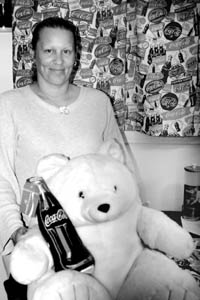![[Metroactive Features]](/features/gifs/feat468.gif)
[ Features Index | Silicon Valley | Metroactive Home | Archives ]
Collector Calling
For collectors of the weird and wonderful, the world can never have enough stuff
IN COPENHAGEN in the mid-1600s, the joltingly named Danish philosopher Olé Worm displayed for the edification of visitors from around Europe an astonishing collection of natural and man-made treasures. Among the many delights crowding Olé Worm's Kunst- und Wunderkammer (room of art and marvels) were "tortoise shells, an armadillo, the spiral tusk of the narwhal ...; a kayak was suspended from the ceiling ...while spears, bows and arrows, articles of clothing and musical instruments were arranged on the walls and shelves," not to mention a "replica in miniature of Giovanni da Bologna's Rape of the Sabine Women" (as related by Joy Kenseth in The Age of the Marvelous).
In the beginning, museums were "cabinets of curiosities," and little distinction was made between art and artifact. The early curators were really private collectors, hoarders even, like Holy Roman Emperor Rudolf II (1552-1612), whose insatiable urge to own specimens of everything that piqued his interest blinded him to the pressing duties of statecraft.
Eventually, the paintings, the sculptures and the high-brow works got organized into big-budget art museums, while the stuff of marvels was scattered into niche institutions. This process led, inexorably, on the one hand, to the Louvre, and on the other, to such triumphs of individual persistence as the much-lamented Barbie Doll Hall of Fame in Palo Alto and the still flourishing Museum of Pez Memorabilia in Burlingame.
Our area is home to many eccentric collections, from garbage to vintage airplanes to Coca-Cola accouterments. In these days of accelerated obsolescence, even the quotidian objects of a century ago seem wondrous when gathered into local-history museums: Did people really dry clothes with a hand wringer? Computers date so quickly that the chips of a decade ago look as strange as the fossils in a natural history museum, as a visit to the Intel Museum will attest.
For this issue, we have chosen to highlight some of our favorite specialized collections of the odd and outré, ranging from local history to transportation to computers. Perhaps they can serve, briefly at least, to distract us from pressing matters of statecraft.
Michael S. Gant
Favorite Local Collections
Rite of Pez-age: The Museum of Pez Memorabilia in Burlingame.
The Hole Truth: Lou's Living Donut Museum in San Jose.
Composing a Life: The Ira F. Brilliant Center for Beethoven Studies at San Jose State University.
Waste Not: The Garbage Museum in Milpitas.
Lofty Ambitions: The Wings of History Museum in San Martin.
High-Tech Hit Parade: The Intel Museum in Santa Clara.
History Lesson: The Japanese-American Museum of San Jose.
Beyond the Doily: The Lace Museum in Sunnyvale.
Museums: A complete guide to local museums.
[ Silicon Valley | Metroactive Home | Archives ]
Copyright © Metro Publishing Inc. Metroactive is affiliated with the Boulevards Network.
For more information about the San Jose/Silicon Valley area, visit sanjose.com.
![]()

Coca Cult: Catherine 'Cat' Stevens displays more than 200 items of Coca-Cola merchandise in the small three-bedroom downtown San Jose home she shares with roommates--unofficially dubbed 'The Coca Cola Museum.' The medical-billing specialist began collecting everything from logo-emblazoned Polar Bears to Coca-Cola Party Barbies 25 years ago with purchases from garage sales and thrift shops, and gifts from friends. Unlike many celebrities, Stevens imbibes what she endorses, consuming about a six-pack of the carbonated beverage every day.
Send a letter to the editor about this story to letters@metronews.com.
From the March 13-19, 2003 issue of Metro, Silicon Valley's Weekly Newspaper.